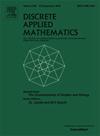图的无符号拉普拉斯能量和谱半径
IF 1
3区 数学
Q3 MATHEMATICS, APPLIED
引用次数: 0
摘要
对于图G,无符号拉普拉斯能量定义为EQ(G)=∑i=1nqi−2mn,其中n为阶数,m为大小,qi为G的第i大的无符号拉普拉斯特征值。本文推广了众所周知的q1≥Δ+1的下界,建立了图G的无符号拉普拉斯谱半径在度和平均2度上的尖锐下界。作为应用,我们给出了连通图和二部图的无符号拉普拉斯能量的明显下界和上界。所涉及的所有极值图都被表征。本文章由计算机程序翻译,如有差异,请以英文原文为准。
Signless Laplacian energy and spectral radius of a graph
For a graph , the signless Laplacian energy is defined as , where and are the order and the size, and is the th largest signless Laplacian eigenvalue of , respectively. In this paper, we establish a sharp lower bound of the signless Laplacian spectral radius of a graph in terms of the degree and the average 2-degree, generalizing a well-known lower bound that . As applications, we give sharp lower and upper bounds of its signless Laplacian energy for a connected graph and a bipartite graph. All extremal graphs involved are characterized.
求助全文
通过发布文献求助,成功后即可免费获取论文全文。
去求助
来源期刊

Discrete Applied Mathematics
数学-应用数学
CiteScore
2.30
自引率
9.10%
发文量
422
审稿时长
4.5 months
期刊介绍:
The aim of Discrete Applied Mathematics is to bring together research papers in different areas of algorithmic and applicable discrete mathematics as well as applications of combinatorial mathematics to informatics and various areas of science and technology. Contributions presented to the journal can be research papers, short notes, surveys, and possibly research problems. The "Communications" section will be devoted to the fastest possible publication of recent research results that are checked and recommended for publication by a member of the Editorial Board. The journal will also publish a limited number of book announcements as well as proceedings of conferences. These proceedings will be fully refereed and adhere to the normal standards of the journal.
Potential authors are advised to view the journal and the open calls-for-papers of special issues before submitting their manuscripts. Only high-quality, original work that is within the scope of the journal or the targeted special issue will be considered.
 求助内容:
求助内容: 应助结果提醒方式:
应助结果提醒方式:


